QIM 1: Proportion of regular clients with diabetes with an HbA1c result recorded in their GP record within the previous 12 months
On this page:
Overview
Patients with Type 1 and 2 diabetes should have their glycosylated haemoglobin (HbA1c) measured at least every 12 months, or more frequently depending on the level of blood glucose control. The early identification and optimal management of diabetes can delay the progression of disease, improve quality of life, increase life expectancy and decrease the need for high-cost interventions (RACGP 2020d).
Capture of results recorded outside of the general practice setting
Some patients may receive care from other practitioners in addition to a GP, including an endocrinologist/a specialist physician, and/or other health care providers to safely manage their diabetes (RACGP 2020d). Results arising from clinical intervention conducted outside of the service that are known and recorded by the practice are included in the measure. However, sometimes an HbA1c result recorded elsewhere is not captured in the report. For example, this might be a result from a specialist service that is not recorded in the clinical information system (CISs) of the client’s usual general practice due to an incompatible CISs between a practice and a specialist service.
Other sources of relevant data
Data on the prevalence of long-term health conditions like diabetes are captured in the National Health Survey (NHS) conducted by the Australian Bureau of Statistics (ABS). There are other administrative data collections where the data from these client-provider interactions are captured, for example, Medicare Benefits Schedule (MBS), the National Diabetes Service Scheme (NDSS) register and the Australasian Paediatric Endocrine Groups (APEG) state and territory registers.
This indicator reports on the proportion of regular clients of all ages who had a recorded diagnosis of Type 1, Type 2 or undefined diabetes, and who had an HbA1c result recorded within the previous 12 months in their GP record.
The QIM proportions summarised by the different extraction tools in use are also shown in the ‘Regional proportions’ bar charts for this measure. This illustrates the differences in how software providers have interpreted the technical specifications and coding of QIMs.
Regional proportions of regular clients with diabetes and a current HbA1c result
QIM 1: Regional proportions
Type 1 diabetes
Type 1 diabetes is a lifelong autoimmune disease that usually has its onset in childhood or early adolescence. The exact cause is unknown, but it is believed to be the result of an interaction of genetic and environmental factors. The management of an individual with Type 1 diabetes requires a multidisciplinary healthcare network delivering integrated clinical care, using a complex array of health care tools (APEG and ADS 2011). A person with Type 1 diabetes requires daily insulin replacement to survive, except in cases where a pancreatic or islet cell transplant occurs. Between 2000 and 2021, there were around 58,000 new diagnoses of type 1 diabetes across all ages, which equates to around 2,700 diagnoses a year. In children and young adults (aged 0-19), around 13,200 were reported to have Type 1 diabetes in 2021. This equates to 211 per 100,000 population, with a similar rate between males and females (AIHW 2023b).
As of July 2023, nationally, 57.6% of regular clients of all ages who had a recorded diagnosis of Type 1 diabetes had an HbA1c result recorded within the previous 12 months in their GP record. This varied from 43.9% to 74.3% across PHNs, and between 48.0% and 59.4% across extraction tools.
Figure 6: Proportion of regular clients with a recorded diagnosis of Type 1 diabetes and an HbA1c result recorded in their GP record within the previous 12 months, by PHN, or extraction tool (ET), July 2023
This bar chart shows the proportion of regular clients with a recorded diagnosis of Type 1 diabetes and an HbA1c result recorded in their GP record within the previous 12 months, by PHN and extraction tool for July 2023.
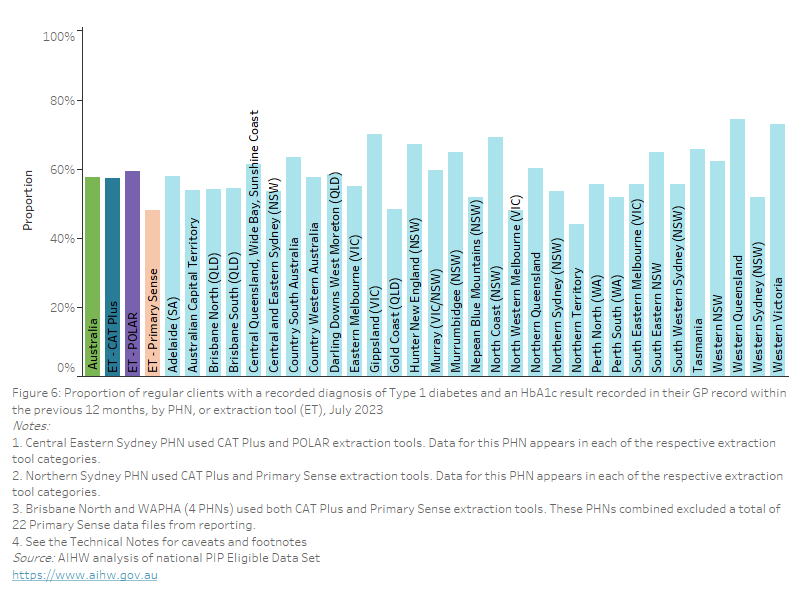
Type 2 diabetes
Type 2 diabetes is a chronic and progressive medical condition that results from 2 major metabolic dysfunctions: insulin resistance followed by pancreatic islet cell dysfunction, causing a relative insulin deficiency. These metabolic dysfunctions occur due to modifiable lifestyle-related risk factors interacting with non-modifiable and genetic risk factors. The relative insulin deficiency leads to chronic hyperglycaemia and multiple disturbances in carbohydrate, protein and fat metabolism (RACGP 2020d). Type 2 diabetes is the most common form of diabetes, generally having a later onset than Type 1 diabetes. People with Type 2 diabetes produce insulin, but do not produce enough, and/or cannot use it effectively. It involves a genetic component, but is largely preventable and is often associated with lifestyle factors including physical inactivity, poor diet, being overweight or obese, and tobacco smoking. Type 2 diabetes can be managed with changes to diet and exercise, oral glucose-lowering medications, non-insulin injectable glucose-lowering medications, insulin injections or a combination of these methods (RACGP 2020d). Although it has typically been considered a disease of older people, reports show that it is being diagnosed at younger ages than in the past. In 2020-21, almost 1.2 million (4.5%) Australians had Type 2 diabetes (ABS 2021b).
As of July 2023, nationally, 71.6% of regular clients of all ages who had a recorded diagnosis of Type 2 diabetes had an HbA1c result recorded within the previous 12 months in their GP record. This varied from 61.4% to 82.1% across PHNs, and between 65.7% and 73.3% across extraction tools.
Figure 7: Proportion of regular clients with a recorded diagnosis of Type 2 diabetes and an HbA1c result recorded in their GP record within the previous 12 months, by PHN, or extraction tool (ET), July 2023
This bar chart shows the proportion of regular clients with a recorded diagnosis of Type 2 diabetes and an HbA1c result recorded in their GP record within the previous 12 months, by PHN and extraction tool for July 2023.
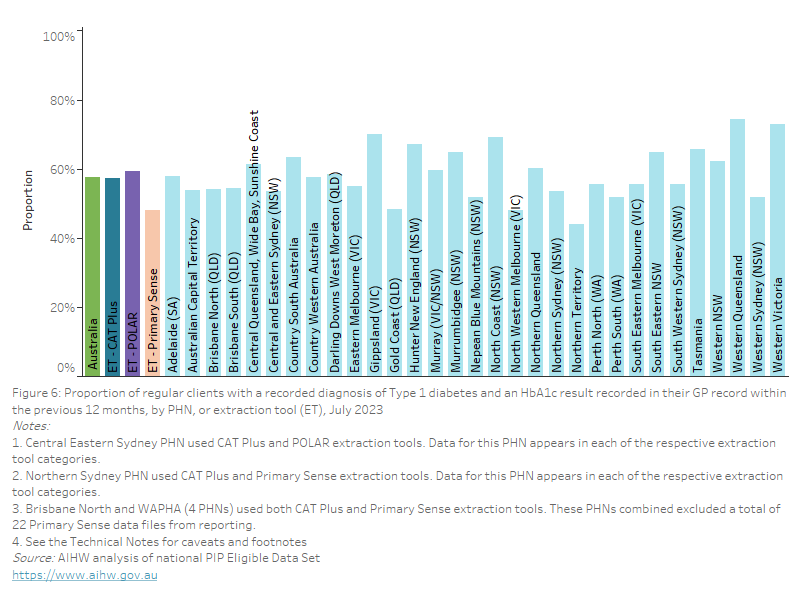
Undefined diabetes
As of July 2023, nationally, 64.7% of regular clients of all ages who had undefined diabetes recorded had an HbA1c result recorded within the previous 12 months in their GP record. This varied from 52.2% to 77.3% across PHNs, and between 59.8% and 68.7% across extraction tools.
Figure 8: Proportion of regular clients with undefined diabetes recorded and an HbA1c result recorded in their GP record within the previous 12 months, by PHN, or extraction tool (ET), July 2023
This bar chart shows the proportion of regular clients with a recorded diagnosis of undefined diabetes and an HbA1c result recorded in their GP record within the previous 12 months, by PHN for July 2023
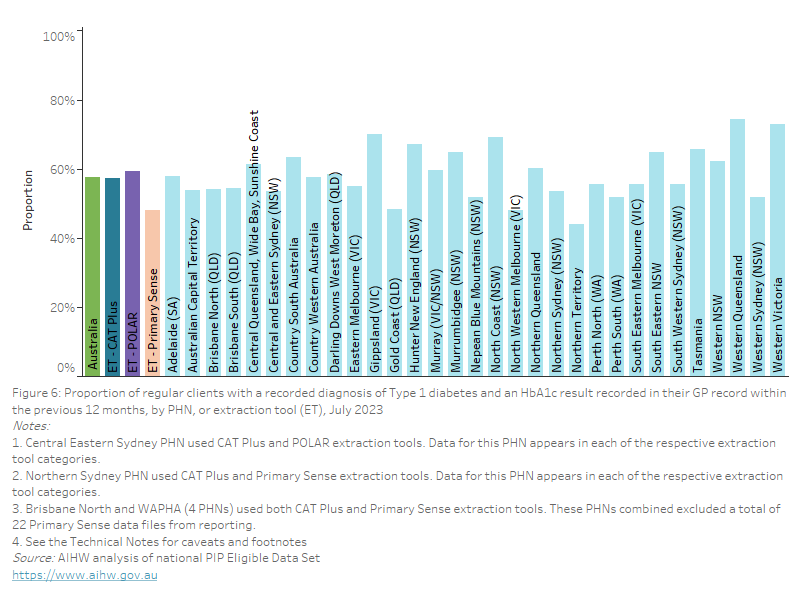
QIM 1: National proportions over time
Nationally, between January 2023 and July 2023, the proportion of regular clients of all ages who had an HbA1c result recorded within the previous 12 months in their GP record with:
- Type 1 diabetes remained constant at 57.1% and 57.6%, respectively
- Type 2 diabetes remained constant at 71.4% and 71.6%, respectively
- Undefined diabetes remained constant at 64.4% and 64.7%, respectively.
Figure 9: Proportion of regular clients with a recorded diagnosis of diabetes (Type 1, Type 2 and undefined) and an HbA1c result recorded in their GP record within the previous 12 months, January 2023 to July 2023
This line chart shows the proportion of regular clients with a recorded diagnosis of diabetes (Type 1, Type 2 and undefined) and an HbA1c result recorded in their GP record within the previous 12 months, from January 2023 to July 2023.
%3dQIM1+-+DIABETES+TYPE&embed_code_version=3&tabs=no&toolbar=no&showAppBanner=false)
National proportion of regular clients with diabetes and a current HbA1c result by age and sex
QIM 1: National proportions by age and sex
Type 1 diabetes
As of July 2023, nationally, the proportion of regular clients of all ages who had Type 1 diabetes and who had an HbA1c result recorded within the previous 12 months in their GP record increased with age and was:
- highest in the 65 years and over age group for both females (72.6%) and males (72.5%)
- lowest in the 0–14 years age group for both females (18.6%) and males (17.6%).
Figure 10: Proportion of regular clients with Type 1 diabetes and an HbA1c result recorded in their GP record within the previous 12 months, by age and sex, July 2023
This bar chart shows the proportion of regular clients with Type 1 diabetes and an HbA1c result recorded in their GP record within the previous 12 months, by age and sex for July 2023.
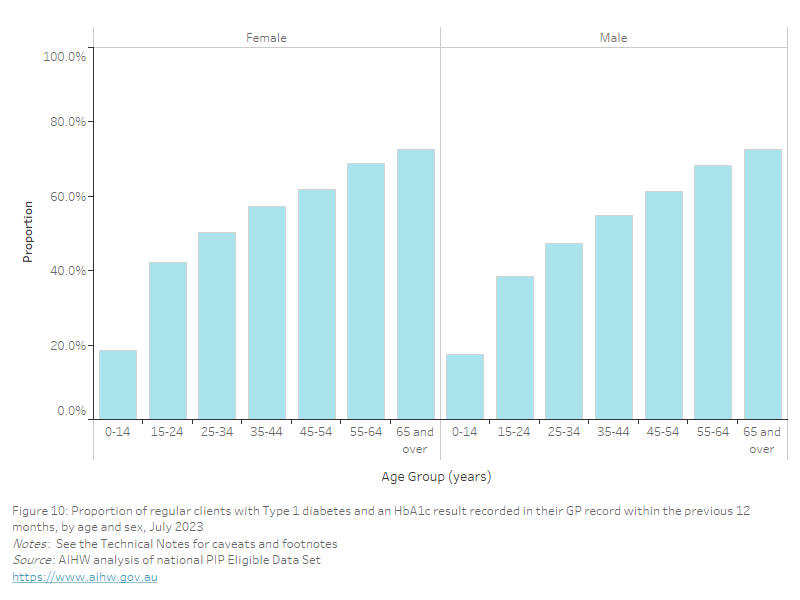
Type 2 diabetes
Type 2 diabetes has typically been considered a disease of older people, but reports show that it is being diagnosed at younger age groups than in the past. Type 2 diabetes in very young children is extremely rare and data from both overseas and Australia suggests that it is unlikely to occur among those under the age of 4 and is generally rare under the age of 10 (AIHW 2014). Diagnosing and managing Type 2 diabetes in the paediatric and adolescent population pose challenges due to the confluence of physiological insulin resistance associated with puberty and the presentation of Type 2 diabetes. In Australia, the incidence of Type 2 diabetes in individuals under 17 years of age was about two per 100,000 person-years, with a 27% average annual adjusted overall incidence increase between 1990 and 2002 (RACGP 2016). Figures showing the proportion of regular clients with type 2 diabetes with HbA1c recorded in their GP recorded for those aged 0-14 years, should be interpreted with these caveats in mind.
As of July 2023, nationally, the proportion of regular clients of all ages who had Type 2 diabetes and who had an HbA1c result recorded in their GP record within the previous 12 months also increased with age and was:
- highest in the 65 years and over age group for both females (73.0%) and males (74.5%)
- lowest in the 0–14 years age group for both females (18.4%) and males (15.7%).
Figure 11: Proportion of regular clients with Type 2 diabetes and an HbA1c result recorded in their GP record within the previous 12 months, by age and sex, July 2023
This bar chart shows the proportion of regular clients with Type 2 diabetes and an HbA1c result recorded in their GP record within the previous 12 months, by age and sex for July 2023.
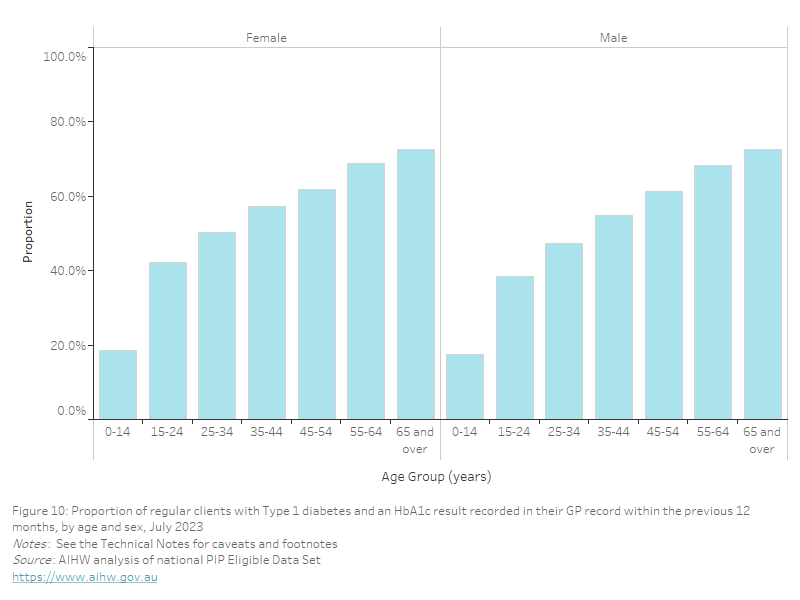
Undefined diabetes
As of July 2023, nationally, the proportion of regular clients of all ages who had undefined diabetes and who had an HbA1c result recorded in their GP record also increased with age and was:
- highest in the 65 years and over age group for both females (66.4%) and males (67.8%)
- lowest in the 0–14 years age group for both females (15.5%) and males (11.6%).
Figure 12: Proportion of regular clients with undefined diabetes and an HbA1c result recorded in their GP record within the previous 12 months, by age and sex, July 2023
This bar chart shows the proportion of regular clients with undefined diabetes and an HbA1c result recorded in their GP record within the previous 12 months, by age and sex for July 2023
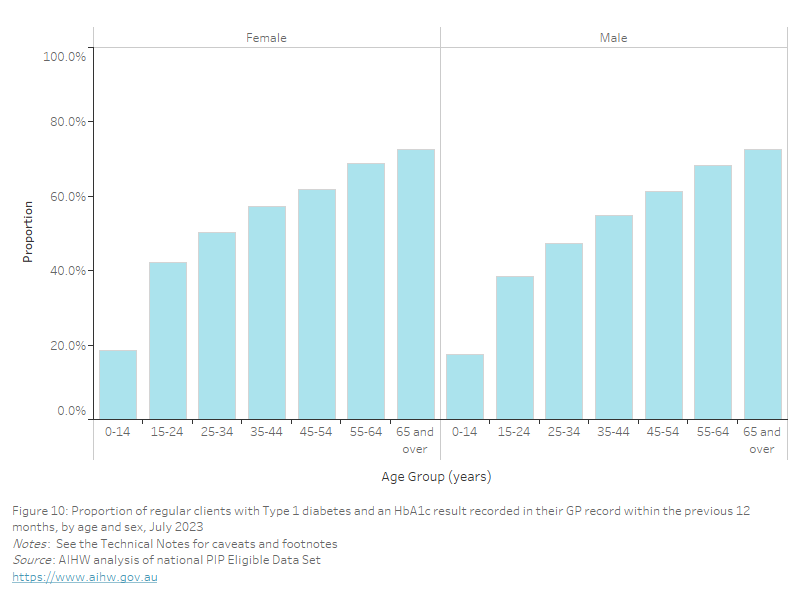
- A client is classified as having diabetes for this measure, if they have Type 1 or Type 2 or undefined diabetes as a diagnosis in their GP record.
- Clinical definitions for diabetes vary across CISs, as different coding schemes are used. This may lead to some variation in the number of clients who will be picked up by different systems (AIHW 2023f).
- Any clients who had gestational diabetes but also have Type 1 or 2 diabetes are included in the measure.
- Multidisciplinary care delivered by multiple providers are often required to safely manage patients with diabetes and its complications. For example, younger patients and patients with Type 1 diabetes are more likely to receive shared care from specialist services. Missing information on HbA1c for these patients could relate to the information not being shared electronically between the specialist services and general practices.
- Results arising from measurements conducted outside of the service that are known and recorded in the GP record are included.
- Clients are excluded from the measure if they:
- had secondary diabetes, gestational diabetes mellitus (GDM), previous GDM, impaired fasting glucose, impaired glucose tolerance,
- had results from measurements conducted outside of the service which were not available to the service and had not visited the service in the previous 12 months.
- There are other administrative data collections where the data from these client-provider interactions are captured, for example, Medicare Benefits Schedule (MBS), the National Diabetes Service Scheme (NDSS) register, the Australasian Paediatric Endocrine Groups (APEG) state and territory registers.
ABS (Australian Bureau of Statistics) (2021b) Diabetes, ABS, Canberra, accessed 11 July 2023.
AIHW (Australian Institute of Health and Welfare) (2014) Type 2 diabetes in Australia’s children and young people: a working paper. Diabetes Series no. 21. Cat. no. CVD 64, AIHW, Canberra, accessed 11 August 2023.
AIHW (2023b) Diabetes: Australian facts, AIHW, Canberra, accessed 12 July 2023.
AIHW (2023f) First Nations-specific primary health care: results from the nKPI and OSR collections, AIHW, Canberra, accessed 03 August 2023.
APEG (Australasian Paediatric Endocrine Group) and ADS (Australian Diabetes Society) (2011) National evidence-based clinical care guidelines for Type 1 diabetes in children, adolescents and adults, Department of Health, Canberra, accessed 9 July 2023.
RACGP (The Royal Australian College of General Practitioners) (2016) Type 2 diabetes mellitus in children and adolescents , RACGP, East Melbourne, Victoria, accessed 11 August 2023.
RACGP (2020d) Management of type 2 diabetes: A handbook for general practice, RACGP, East Melbourne, Victoria, accessed 2 August 2023.


